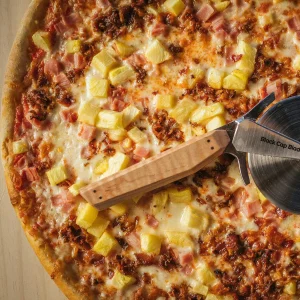Article by Addison Austin-Lou, 2024 HRN Research and Radio Intern
Hawaiian pizza is without a doubt the most controversial slice you’ll ever take a bite of. Americans are split almost dead even on whether they like it as a topping or not. In 2017 Jimmy Kimmel took to the airwaves with a blistering critique of this sweet and savory slice. He cited a tweet by Canadian Prime Minister Justin Trudeau stating “I have a pineapple. I have a pizza. And I stand behind this delicious Southwestern Ontario creation. #teampineapple.”
Yes, you read that correctly. Hawaiian pizza was not in fact invented in Hawai’i, but rather a small town in Ontario in 1962. Pizza didn’t take hold in North America until the 1950s, and even then it was a little slow on the uptake having originally been seen as a poor Italian immigrant food by well-to-do Americans. Once Italians gained a higher socioeconomic status their cuisine was accepted in a wider capacity.
In 1954 a twenty-year old Greek man named Sam Panopoulos set sail on a ship bound for Canada. A brief stop in Naples enroute gave him his first taste of pizza. Upon arriving in his new home country Panopoulos set down roots in Chatham, Ontario near the banks of Lake Eerie. Shortly thereafter with the help of his two brothers he opened a diner called the Satellite. They served standard fare for the time but Panopoulos enjoyed mixing it up and introducing his customers to new things.
An Asian chef was hired and Chinese food added to the menu, which set the stage for experimentation with sweet, sour, and savory flavor combinations. After a trip to the nearby city of Windsor where pizza had recently hopped over the river from Detroit, Panopoulos was determined to bring it back to the Satellite. Pizza-making techniques he saw there left a lot to be desired. The only toppings at the time were canned mushrooms, shredded cheese, bacon, or pepperoni atop pre-made dough cooked in electric ovens.
If you know anything about pizza you know it’s all about the dough! While Hawaiian pizza starts its own heated debates, regional pizza styles are constantly duking it out to see which is the best. No matter the style though, you’ve got to start with the right flour. Thirteen-time World Pizza Champion Tony Gemignani knows the power of the flour and even designed his own in collaboration with Central Milling.
Founded in 1867, Central Milling is one of the oldest flour mills in America, providing the finest quality flour and grains to homes and bakeries across the country. The company contracts directly with wheat producers to sustainably grow grains that have exceptional flavor, nutrient content, color, and baking performance.
Just in case you’re wondering, yes, Tony does make a Hawaiian pizza at one of his restaurants. It includes full pineapple rings and three types of pork: honey bacon, smoked ham, and prosciutto di parma. Hard to argue with that. But back to where it all started.
Sam Panopoulos, with little knowledge of pizza tradition, started trying different combinations of toppings. Pineapple had become a staple in many kitchens following the return of soldiers from WWII. They had been stationed in the South Pacific and returned with a taste for things that reminded them of tropical paradise.
This led to a wave of interest in “Tiki culture,” an idealized and culturally insensitive approach to food, beverage, and decoration that swept across North America. Add in Hawaii’s statehood in 1959, and pineapple was perfectly poised to make an appearance on pizza. Panopoulos has said in interviews that at first people were quite taken aback, before falling in love with the quirky new combination. He named it the Hawaiian Pizza after the brand of canned pineapple he used. There is some debate about whether he was truly the first to invent this particular flavor combination.
German TV Chef Clemens Wilmenrod introduced “Toast Hawaii” on his show in 1955. This dish is an open faced sandwich that consists of toasted bread, ham and cheese melted over a pineapple ring with a maraschino cherry in the middle. This may have been an iteration of the “spamwich,” that had once been popular in the United States though. Aside from the use of ham instead of spam and the addition of the cherry, they are identical recipes.
The Satellite was sold in 1972 and remains open under new management to this day. Panopoulos passed away in 2017. Needless to say his legacy lives on. Hawaiian pizza can now be found from the freezer aisle to upscale pizza joints like Tony Gemignani’s San Francisco speakeasy Capo’s. Whether you enjoy those island vibes on your slice or can’t stand pineapple anywhere near it this is one culinary chronicle we can all agree is pretty delicious to lern.
